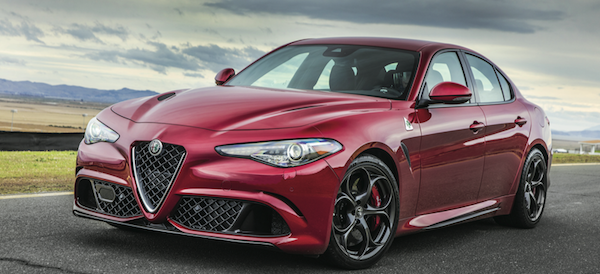There are some who say you can tell a lot about a country, and its people, by the cars it produces. Okay, no one says that, but it’s a pretty good opening line so hang with me for a minute. The Alfa Romeo Giulia is all-Italian— sleek, sophisticated, nimble, quick, and maybe a little quirky. The Dodge Challenger SRT Hellcat is straight-ahead Detroit iron, and it leads with its power numbers—of course, if you had 707 horsepower (not a typo), you might lead with that too. So maybe it’s worth delving a little deeper into what makes each tick and what each says about its country of origin. Both are creations of FCA (Fiat Chrysler Automobiles), but there aren’t a lot of family resemblances between them. Let’s start with the sleek Italian.
The Alfa Romeo Giulia comes in two basic gelatos: The standard one has 280 horsepower, but the Quadrifoglio, denoted with the four-leaf clover on the sides of the front fenders, is a different kettle of lasagna. It feels like a car designed to knock the BMW M3 off its throne and drag the competitors from Mercedes, Audi, and even Cadillac with it. The Alfa 4-Leaf has prodigious power (505 horses) and is close to the near-perfect 50-50 weight distribution (the weight of the car over front wheels/rear wheels).
It boasts an eight-speed transmission with a lever in the center console plus today’s obligatory paddle shifters, and it goes through the gears like a hot knife through butter—this car lays it down really smoothly, assisted, no doubt, by a carbon-fiber driveshaft. It does so quickly, hitting 60 mph in under four seconds, and it holds the lap record for a production four-door sedan at Germany’s fabled Nürburgring race track (7:32 minutes). This puts it just a tick behind such luminaries as the Ferrari 488 Italia and the McLaren MP4 12C—yet the Alfa still has a place to put the children’s car seat and groceries in the back. Nevertheless, the Alfa doesn’t make the people inside pay for all that performance, as there’s plenty of room fore and aft, and with four doors, it’s an easy-in, easy-out car too.
The sophistication extends to the “active-aero” component. The front splitter (the area below the front grille) automatically adjusts to provide more downforce (weight over the front wheels, to help it stay connected with the road), an important consideration for a car like this, with a top speed of 191 mph (which I didn’t get anywhere near during my one-week experience with this car—well, not really near—actually (redacted on advice of counsel). Thoughtfully, Alfa provided beautiful Brembo calipers to bring it back to zero quickly.
The Alfa is not just a straight-line stormer, though. With rear-wheel drive and Alfa’s “DNA Pro Drive Mode Selector,” one can choose between four setups: “D”ynamic, “N”atural, “A”dvanced Efficiency (economy), or “R”ace modes. Calling it “DNA” was apparently so important to Alfa that it thought DNAR wouldn’t cut it. And what’s “Natural” mode anyway?
Semantics aside, it’s a ton of fun to drive a car that allows an adjustment to engine mapping (how fast the throttle responds), suspension firmness, and my favorite: exhaust note. The car speaks Italian like a big lady with a shield and a spear, so you better pay attention. Need I say that I only toggled between Dynamic and Race—okay, I used Dynamic once when going out to get milk and eggs.
And then there’s the Hellcat. Not much left to the imagination here—the snarling sabre-tooth feline head on the front fender is a pretty good clue that you’re in for something rough and wild. Surprisingly, however, it’s not all lumps and bumps for those lucky enough to get a ride in this American screamer.
“Mine” had a six-speed manual and it was slick—shifts were positive, smooth, and sharp, allowing one to put power to the pavement with a minimum of wheelspin (unless, of course, one had never outgrown his juvenile tendencies, in which case it was happy to paint the road black with no effort at all). Finally, a vehicle that allowed me to amortize all of the time spent practicing heel-and-toe downshifts! And how rewarding those were, given the roar elicited by the throttle blip. I kept hearing Jay Leno’s immortal words: “There’s no replacement for displacement!”
I assume that the moniker Hellcat just garnered more votes than Testosteroneo. That or maybe some suit was worried that the alternative sounded too much like a Ferrari red head. Either way, this car is a teenage boy’s dream, no matter how old he is. It’s really the best of the muscle car era, if “best” means excellent brakes, great cornering, and power that’s in the neighborhood of 250 percent above what Detroit churned out in the 1960s.
A brief side note—as I write this, the Dodge Demon has been announced, and for those for whom 707 horsepower is a good starting point, your ride is on the way. The Demon, designed for drag-strip use, will check in at about 840 horsepower with a projected 0 to 60 time of 2.3 seconds and, wait for it, it’s the world’s first production car that can do a wheelie. All I can say is “wow” (oh, and “I want one”). History buffs may remember the Chrysler “C” cars of the 1950s, the most powerful of which supposedly required a doctor’s note to prove that the buyer could handle the power. The Demon may require an EKG and the consent of your next-of-kin.
My time with the two FCA–created cousins was coming to an end, and I really didn’t want to give back either of them. Both had their high points and surprisingly few low points. I loved my time behind the wheel of both, and, interestingly, they’re roughly in the same price range. They both did their jobs well, but, boy, did they come at the task differently. Luckily for many of our readers, one could buy both for the price of a well-optioned Porsche, so both Dr. Jekyll and Mr. Hyde each could have his favorite.























